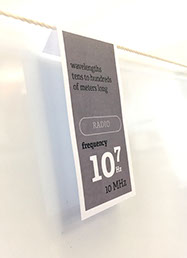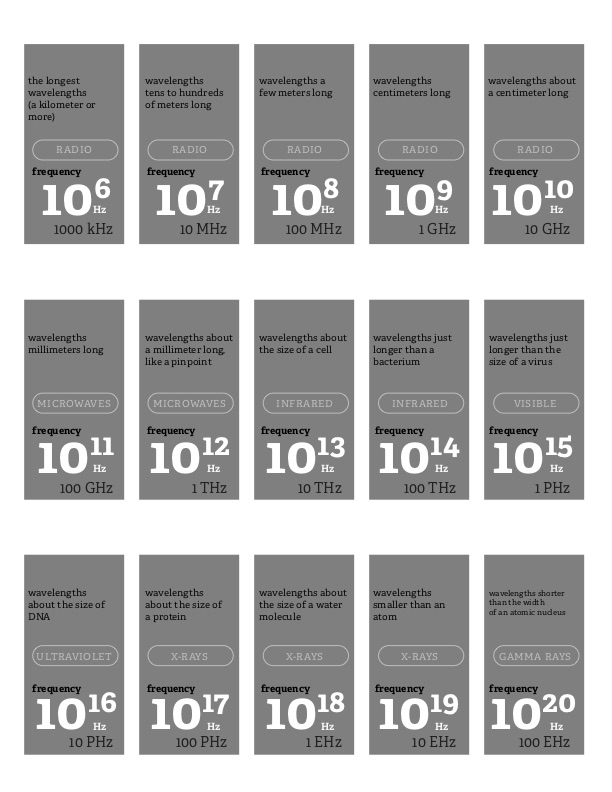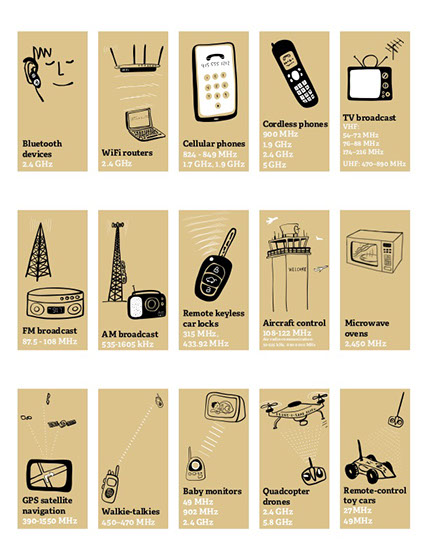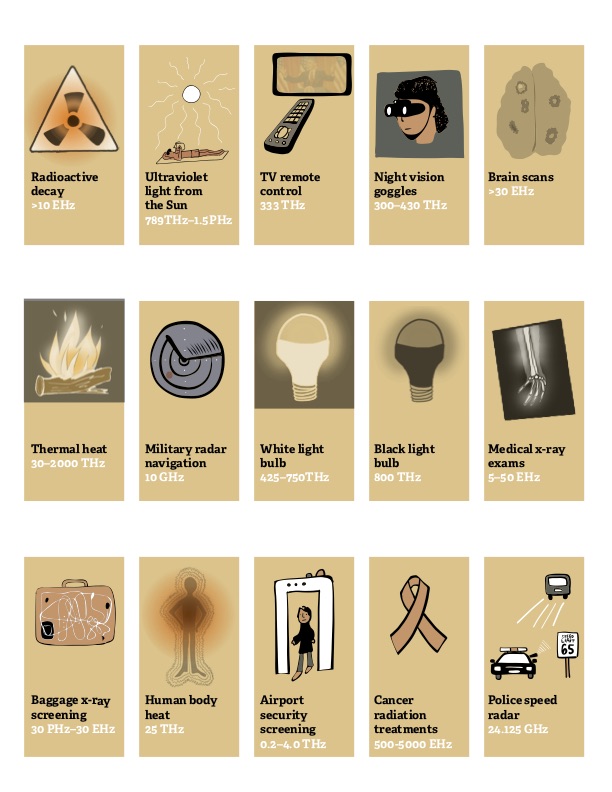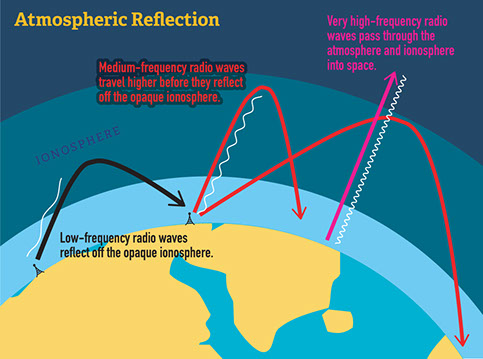SciGen Teacher Dashboard
Flash to Bang
Waves without a Medium
The Electromagnetic Clothesline
Making the Invisible Visible
All-Star Alien Hide and Seek
Project: The Electromagnetic Clothesline
Duration: Approximately 45 minutes plus optional 10-minute extension
This exploratory activity considers the wide range of frequencies and wavelengths within the electromagnetic spectrum. It focuses on what happens in a very crowded part of the electromagnetic spectrum: the radio waves with frequencies measured in gigahertz. It then considers electromagnetic waves of higher frequencies—microwaves, infrareds, visible light, ultraviolets, x-rays, and gamma rays—and asks how the Earth's atmosphere, ionosphere, and magnetosphere protect humans.
LEARNING OBJECTIVES
Students distinguish mechanical from electromagnetic waves.
Students learn that the electromagnetic spectrum contains radiation that is both visible and invisible, helpful and harmful.
Students see that while electromagnetic waves transport energy, they require no medium.
Teacher Tips
- You can construct one electromagnetic clothesline as a class or have students split into as many groups as your classroom can accommodate, assuming that each clothesline is about 3 meters (10 feet) long.
- Some students may not respond well to the unfamiliar terminology used when describing waves. Judge whether your students would absorb the material better if you use the word "electromagnetic" or abbreviate it "EM." Calling all EM waves "light waves" is simpler and technically accurate (since all EM waves travel at the speed of light) but may confuse students who will think only of visible light. For more on challenges using text, see the SERP materials on Reading to Learn in Science.
-
Instead of printing and cutting the hanging cards in this exercise, you may choose to have the students use sticky notes or scraps of paper to build their electromagnetic spectrum, using the sheets as a reference guide. This is especially helpful for noting the
electromagnetic
waves that happen at various frequencies.
- When the students read and write, students read more deeply for understanding than if they just cut the cards out. Using cut-out cards provides scaffolding for special education students, ELLs, students who have fine motor issues, and others who may need some assistance. Or you may want to minimize the time the students spend on this part of the activity!
Materials (per clothesline)
-
a long piece of clothesline (or string) of at least 3 meters (10 feet)
- You may choose to have the students create the electromagnetic spectrum flat on a tabletop.
- printouts
-
choose one (see note in Teacher Tips):
- sticky notes
- scissors and clothespins (or paper clips)
Teacher Tune-ups
Teaching Notes
ACTIVITY OVERVIEW
- Check for understanding with an Anticipation Guide (5 minutes)
- Explore the meaning of Hz, kHz, MHz, GHz (5 minutes)
- Set up the logarithmic scale of the clothesline (5 minutes)
- Allocate space on the radio spectrum (10 minutes)
- Allocate space on the rest of spectrum (10 minutes)
- Optional: Explore Earth's protective environment (10 minutes)
- Revisit the Anticipation Guide (10 minutes)
Check for understanding with an Anticipation Guide (5 minutes)
Anticipation guides are useful for activating students' prior knowledge about science concepts and focusing students' attention on key content in a text. They are one of the strategies from SERP's Reading to Learn in Science (RTLS), all of which can be helpful to science teachers when the lesson requires some student engagement with text.
Before going through the lesson, have students decide whether they think each statement is true or false. After today's lesson, you will have students reassess which statements in the anticipation guide are true and false, noting evidence from the lesson.
What I think:
Humans can see all light. TRUE • FALSE
All radiation hurts humans. TRUE • FALSE
If something makes electromagnetic radiation, it glows. TRUE • FALSE
Waves transport energy, not matter. TRUE • FALSE
All waves need something, a medium, to travel through. TRUE • FALSE
Radio waves are a kind of light wave. TRUE • FALSE
Radio waves move more slowly than the speed of sound. TRUE • FALSE
Explore the meaning of Hz, kHz, MHz, GHz (5 minutes)
Set up the logarithmic scale of the clothesline (5 minutes)
Allocate space on the radio spectrum (10 minutes)
Allocate space on the rest of spectrum (10 minutes)
Review electromagnetic clotheslines (10 minutes)
Give students a few minutes to walk around the room and look at one another's clotheslines a bit closely. Students may check each other’s clotheslines for possible mistakes (such as a card being in the wrong place.)
Have kids brainstorm any other possible technologies that exist that might have a place on the clothesline.
Optional: Explore Earth's protective environment (10 minutes)
In an optional diversion, you can explore how "Spaceship Earth" protects earthlings—both human and other animals—from many of the harmful waves that travel across the universe. This same protective quality of the ionosphere is something we exploit to send EM signals around the earth.
Show the slide that illustrates which waves traveling the universe can penetrate the atmosphere and ionosphere.
Paraphrase:
Electromagnetic waves criss-cross the universe. Many of these can easily damage our DNA and kill us. The Earth is surrounded by a protective envelope that keeps many of these harmful waves out of our livable zone. Earth's atmosphere stops most types of electromagnetic radiation from space from reaching Earth's surface. This illustration shows how far into the atmosphere different parts of the EM spectrum can go before being absorbed. Only portions of radio and visible light reach the surface.
Image Credit: STScI/JHU/NASA
Show the slide that illustrates how we use the atmosphere to send radio waves around the world by bouncing it off the ionosphere.
Paraphrase:
The protective shell that keeps some electromagnetic waves out also keeps them in. High frequency waves pass through the ionosphere and escape into space while the low frequency waves reflect off the ionosphere and essentially "skip" around the Earth to get from one place to another.
Image Credit: NASA's Radio JOVE, Solar and Planetary Radio Astronomy for Schools
Revisit the Anticipation Guide (10 minutes)
Now that students have read the text, have them decide again whether they think each statement is true or false, and note evidence from the lesson that backs up their claims.
- Humans can see all light. FALSE (Only a thin sliver of the EM spectrum is visible to the human eye: visible light from red to violet, which combine to make white light.)
- All radiation hurts humans. FALSE (Not all radiation is harmful.)
- If something makes electromagnetic radiation, it glows. FALSE (All types of waves on the EM spectrum are considered EM radiation. While some EM waves are visible to the human eye, a very thin sliver of the EM spectrum "glows.")
- Waves transport energy, not matter. TRUE
- All waves need something, a medium, to travel through. FALSE (Only mechanical waves need a medium in order to propagate.)
- Radio waves are a kind of light wave. TRUE
- Radio waves move more slowly than the speed of sound. FALSE (All electromagnetic waves travel at the speed of light in a vacuum. A medium slows them down. But it would not slow down so much as to be slower than a mechanical wave like sound, whose speed changes depending on the properties of the medium it is traveling through.)
Want to learn more about anticipation guides? They are one of the strategies from SERP's Reading to Learn in Science (RTLS).
What the text says Evidence from the lesson
Humans can see all light. TRUE • FALSE
All radiation hurts humans. TRUE • FALSE
If something makes electromagnetic radiation, it glows. TRUE • FALSE
Waves transport energy, not matter. TRUE • FALSE
All waves need something, a medium, to travel through. TRUE • FALSE
Radio waves are a kind of light wave. TRUE • FALSE
Radio waves move more slowly than the speed of sound. TRUE • FALSE
Anticipation Guide Answers
What the text says Evidence from the lesson
Humans can see all light. TRUE • FALSE
All radiation hurts humans. TRUE • FALSE
If something makes electromagnetic radiation, it glows. TRUE • FALSE
Waves transport energy, not matter. TRUE • FALSE
All waves need something, a medium, to travel through. TRUE • FALSE
Radio waves are a kind of light wave. TRUE • FALSE
Radio waves move more slowly than the speed of sound. TRUE • FALSE
BETA Version - Please send comments and corrections to info@serpinstitute.org

